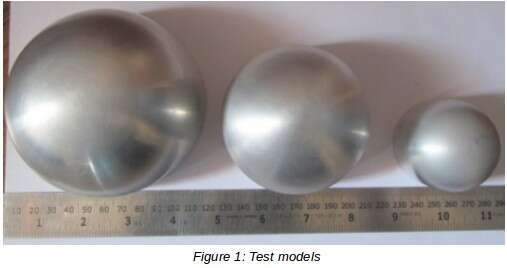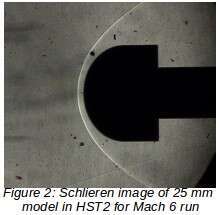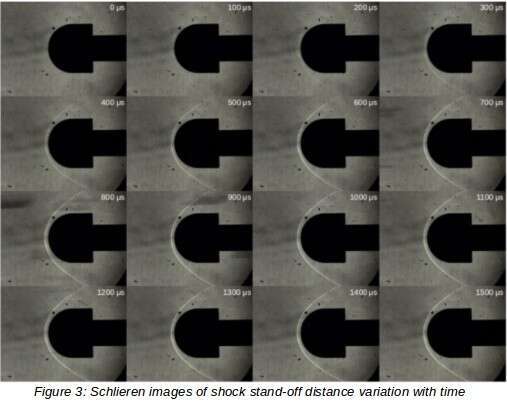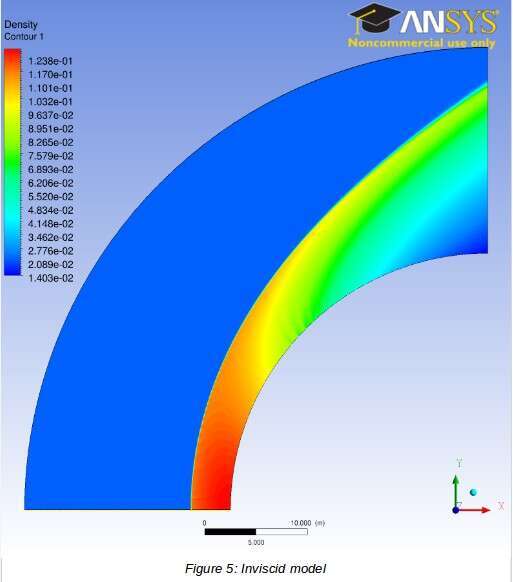
Experimental Analysis of Shock Stand-off Distance in Hypersonic Flows over spherical Bodies
|
| Test gas | M∞ | P0 (kPa) | T0 (K) | P∞ (Pa) |
T∞ (K) |
ρ∞ (kg/m3) |
Re∞ (million/m) |
h0 (MJ/kg) |
| Air | 5.5668 | 962.275 | 1076.442 | 961.809 | 149.550 | 0.0429 | 5.7112 | 1.0813 |
| Air | 8.42 | 1932.571 | 1206.426 | 141.826 | 79.478 | 0.006218 | 1.7173 | 1.2119 |
| Air | 11.25 | 11388.0 | 2490.720 | 86.0 | 109.320 | 0.00290 | 0.9003 | 2.880 |
| CO2 | 6.56 | 2502.296 | 1163.113 | 363.473 | 162.099 | 0.011864 | 1.3986 | 0.9858 |
Schlieren photography was employed to visualize the flow in front of the test models and the shock stand-off distance was discerned from the images using edge detection technique. These experiments were carried out on 3 different spherical models of radii 25 mm, 40 mm, and 50 mm. Each model comprised a hemisphere and a cylindrical after body of 20 mm length. These models were fabricated from Duralumin 2014. Figure 1 shows the test models used in this work.


Figure 2 shows a schlieren image of the 25 mm model in HST2 for a typical Mach 6 run. From the experimental data, it was observed that the shock stand-off distance increases during the flow build up, remains more or less constant during the test time, and increases further during the flow termination.


Figure 3 shows the schlieren images of the shock stand-off distance variation with time for the same Mach 6 run. Figure 4 shows the variation of value of shock stand-off distance with time for the same run. The average value for this run was found to be 3.77 mm from the analysis of the images. The experimental data was compared with that of Lobb and Olivier and a good match within 5% was obtained. For the same flow conditions, Lobb predicted it to be 3.96 mm and Olivier estimated it at 3.97 mm. Figures 5 and 6 show the results of the computations carried out using HiFun for the same free-stream conditions, for inviscid and viscous models respectively. Shock stand-off distance from this analysis was found to be 3.9 mm for both cases. The detailed experimental, analytical and computational results will be provided in full paper.


References
1. M.D. Van Dyke, “The supersonoic blunt-body problem – review and extension”, AIAA Journal, Vol. 25, No. 8, pp 485-496, 1958.
2. R.K. Lobb, “Experimental measurement of shock detachment distance on spheres fired in air at hypervelocities”, The high temperature aspects of hypersonic flow (Nelson ed.), Pergamon press, pp 519-527, 1964.
3. H. Olivier, “A theoretical model for the shock stand off distance in frozen and equilibrium flows”, Journal of Fluid Mechanics, Vol. 413, pp 345-353, 2000.
4. F. Zander, R.J. Gollan, P.A. Jacobs. R.G. Morgan, “Hypervelocity shock stand-off on spheres in air”, Shock Waves, Vol. 24, pp 171-178, 2014.
Powered by Eventact EMS